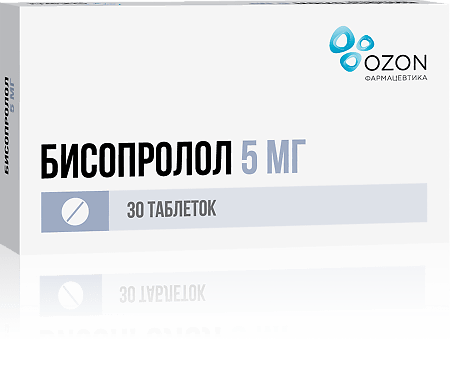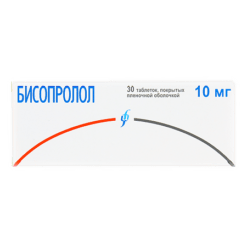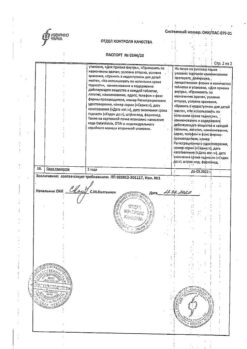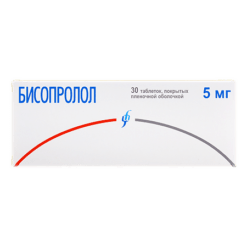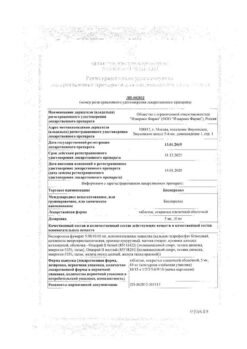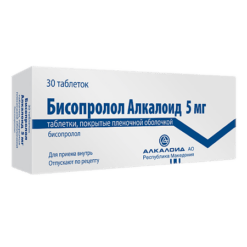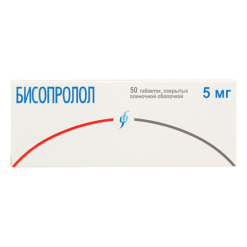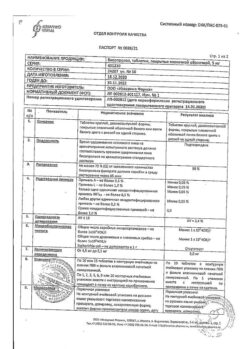No products in the cart.
Bisoprolol, 5 mg 30 pcs.
€2.98 €2.48
Out of stock
(E-mail when Stock is available)
Description
Pharmacodynamics
Bisoprolol is a selective beta1-adrenoblocker without sympathomimetic activity of its own; it has antihypertensive, antiarrhythmic and antianginal effects. By blocking in low doses beta1-adrenoreceptors of the heart, it reduces catecholamine-stimulated formation of cyclic adenosine monophosphate (cAMP) from adenosine triphosphate (ATP), reduces intracellular calcium ions (Ca2+) flow, has negative chrono-, dromo-, batmo- and inotropic effects (decreases heart rate, inhibits conduction and excitability, reduces myocardial contractility).
With increasing dose it has beta2-adrenoblocking effect.
The total peripheral vascular resistance at the beginning of administration of beta-adrenoblockers, in the first 24 hours, increases (as a result of reciprocal increase of alpha-adrenoreceptor activity and elimination of beta2-adrenoreceptor stimulation) which returns to baseline in 1-3 days, and decreases with long-term administration.
The antihypertensive effect is connected with decrease of the minute blood volume, sympathetic stimulation of peripheral vessels, decrease of renin-angiotensin-aldosteron system activity (it is more important for patients with initial renin hypersecretion), restoration of aortic arch baroreceptors sensitivity (their activity in response to arterial pressure (AP) decrease is not increased) and the influence on the central nervous system. In case of arterial hypertension the effect comes in 2-5 days, stable effect – in 1-2 months.
The antianginal effect is caused by decrease of myocardial oxygen demand as the result of shortening of heart rate and contractility, prolongation of diastole, improvement of myocardial perfusion. By increasing left ventricular end-diastolic pressure and increasing ventricular muscle fiber stretch may increase myocardial oxygen demand, especially in patients with chronic heart failure (CHF).
In contrast to non-selective beta-adrenoblockers when administered in medium therapeutic doses, it has less pronounced effect on the organs containing beta2-adrenoreceptors (pancreas, skeletal muscles, smooth muscle of peripheral arteries, bronchi and uterus) and on carbohydrate metabolism, does not cause delay of sodium ions (Na+) in the body. When used in high doses has a blocking effect on both subtypes of beta-adrenoreceptors.
Pharmacokinetics.
Bisoprolol is almost completely absorbed from the gastrointestinal tract (80-90%). Food intake does not affect absorption of the drug. Maximum plasma concentration is reached after 2-3 hours. Binding with plasma proteins is approximately 35%. Hematoencephalic barrier and placental barrier permeability is low, secretion with breast milk is low.
It is metabolized in the liver. Half-life (T1/2) is 9-12 hours, lengthened in impaired renal function (with creatinine clearance less than
40 ml/min – 3 times), in old age, with liver disease (in cirrhosis it increases to 21.7 hours). Excreted by the kidneys – 50% unchanged, less than 2% through the intestines.
Indications
Indications
Active ingredient
Active ingredient
Composition
Composition
1 tablet contains bisoprolol (in fumarate form) 5 mg.
Supplementary substances:
magnesium stearate – 1.2 mg,
colloidal silicon dioxide – 1.2 mg,
crospovidone – 1.2 mg,
corn starch – 15.6 mg,
microcrystalline cellulose – up to 120 mg.
Composition of the film coating:
Opadray II Yellow – up to 123.6 mg (polyvinyl alcohol – 1.44 mg, titanium dioxide – 0.46296 mg, talc – 0.5328 mg, macrogol – 0.7272 mg, iron oxide yellow dye – 0.01404 mg, quinoline yellow dye – 0.42048 mg, orange yellow dye – 0.00252 mg).
How to take, the dosage
How to take, the dosage
In the morning on an empty stomach, without chewing, 5 mg once.
If necessary, the dose is increased to 10 mg once daily.
The maximum daily dose is 20 mg/day. In patients with impaired renal function and creatine clearance less than 20 ml/min or with significant liver dysfunction the maximum daily dose is 10 mg.
Dose adjustment in elderly patients is not required;
Interaction
Interaction
When concomitant use of antacids and antidiarrheals may decrease the absorption of beta-adrenoblockers.
Concomitant use of antiarrhythmic agents may cause a sharp decrease in BP, lower HR, development of arrhythmias and/or heart failure.
The simultaneous use of antihypertensive agents may increase the antihypertensive effect.
Concomitant use of cardiac glycosides may cause conduction disorders.
The concomitant use of sympathomimetics (including those contained in cough products, nasal drops, eye drops) decreases the effectiveness of bisoprolol.
Concomitant use of verapamil, diltiazem may cause a sharp decrease in BP, lower HR, development of arrhythmia and/or heart failure.
Concomitant use of guanfacine may cause marked bradycardia and conduction disturbances.
In concomitant use of insulin, hypoglycemic agents for oral administration, the effect of insulin or other hypoglycemic agents increases (regular monitoring of plasma glucose levels is necessary).
When clonidine is used concomitantly there may be severe bradycardia, arterial hypotension and conduction disorders.
In case of abrupt clonidine withdrawal, patients receiving bisoprolol may experience a sharp increase in BP.
The simultaneous use of nifedipine, other calcium channel blockers, dihydropyridine derivatives increases the antihypertensive effect of bisoprolol.
The simultaneous use of reserpine, alpha-methyldopa may cause marked bradycardia.
Concomitant use of rifampicin may slightly decrease T1/2 of bisoprolol.
The concomitant use of ergotamine derivatives (including migraine medications containing ergotamine) increases symptoms of peripheral circulatory disorders.
Special Instructions
Special Instructions
Control of patients taking Bisoprolol should include measurement of HR and BP (at the beginning of treatment – daily, then once every 3-4 months), ECG, determination of blood glucose level in diabetic patients (once every 4-5 months). In elderly patients it is recommended to monitor kidney function (once every 4-5 months). The patient should be trained in the method of heart rate counting and instructed to consult a physician if the heart rate is less than 50 bpm.
Before starting treatment, it is recommended to perform an external respiratory function study in patients with a history of poor bronchopulmonary function. In about 20% of patients with angina pectoris, beta-adrenoblockers are ineffective. The main reasons are severe coronary atherosclerosis with low threshold of ischemia (heart rate less than 100 bpm) and increased left ventricular end-diastolic volume, which impairs subendocardial blood flow.
The effectiveness of beta-adrenoblockers is lower in “smokers. Patients who use contact lenses should take into account that against the background of treatment a decrease of lacrimal fluid production is possible. When used in patients with pheochromocytoma, there is a risk of paradoxical arterial hypertension (if effective alpha-adrenoblockade has not been previously achieved).
In thyrotoxicosis, Bisoprolol may mask certain clinical signs of thyrotoxicosis (e.g., tachycardia). Abrupt withdrawal in patients with thyrotoxicosis is contraindicated because it can exacerbate the symptoms. In patients with diabetes mellitus it can mask tachycardia caused by hypoglycemia. Unlike non-selective beta-adrenoblockers practically does not increase insulin-induced hypoglycemia and does not delay the recovery of blood glucose concentration to normal levels.
In case of concomitant use of clonidine its use can be stopped only after several days after discontinuation of Bisoprolol.
It is possible that the severity of hypersensitivity reactions will increase and there may be no effect of usual doses of epinephrine against a background of a history of heavy allergology. If scheduled surgical treatment is necessary, the drug is withdrawn 48 hours before the start of general anesthesia. If the patient has taken the drug before the surgery, he should choose the drug for general anesthesia with minimal negative inotropic effect.
The reciprocal activation of the vagus nerve can be eliminated by intravenous injection of atropine (1-2 mg).
Drugs that reduce catecholamine stores (including reserpine) can potentiate the effects of beta-adrenoblockers, so patients taking these combinations of drugs should be under constant medical supervision for signs of marked lowering of BP or bradycardia.
Patients with bronchospastic disorders may be prescribed cardioselective adrenoblockers if other hypotensive medications are intolerant and/or ineffective.
Overdose is dangerous with the development of bronchospasm. In elderly patients with increasing bradycardia (less than 50 bpm), marked BP lowering (systolic BP below 100 mm Hg), AV-blockade it is necessary to reduce the dose or discontinue treatment. It is recommended to discontinue therapy if depression develops.
The treatment should not be abruptly interrupted because of the risk of severe arrhythmias and myocardial infarction. Withdrawal is carried out gradually, reducing the dose over 2 weeks or more (reduce the dose by 25% every 3-4 days). It should be discontinued before testing the blood and urine content of catecholamines, normetanephrine and vanillinmindalic acid, and antinuclear antibody titers.
During treatment, caution should be exercised when driving motor vehicles and engaging in other potentially hazardous activities that require increased concentration and rapid psychomotor reactions.
Contraindications
Contraindications
Side effects
Side effects
Nervous system disorders: weakness, fatigue, dizziness, headache, sleep disorders, mental disorders (depression, rarely – hallucinations), feeling of cold and paresthesias in the extremities.
Cardiovascular system disorders: orthostatic hypotension, bradycardia, AV conduction disorders, occurrence of symptoms of heart failure, worsening of intermittent claudication and basic clinical symptoms in Raynaud’s syndrome.
An organ of vision: decreased secretion of lacrimal fluid, conjunctivitis.
Digestive system disorders: diarrhea, constipation, nausea, abdominal pain.
Muscular system disorders: muscle weakness, muscle cramps.
Skin and subcutaneous tissue disorders: skin itching; in some cases – intensification of psoriasis symptoms, appearance of psoriasis-like rashes.
Respiratory system: in predisposed patients there may be symptoms of bronchial obstruction.
Other: sweating, hot flashes, impaired potency, decreased glucose tolerance in patients with diabetes, allergic reactions.
Overdose
Overdose
Symptoms: arrhythmia, ventricular extrasystole, marked bradycardia, AV block, marked BP decrease, chronic heart failure, cyanosis of finger nails or palms, difficulty breathing, bronchospasm, dizziness, fainting, seizures.
Treatment: gastric lavage and administration of adsorptive drugs;
symptomatic therapy: if AV blockade has developed – intravenous injection of 1-2 mg of atropine, epinephrine, or placement of a temporary pacemaker; if ventricular extrasystole – lidocaine (Class IA drugs are not used ); if BP decreases – the patient should be in the Trendelenburg position; if there are no signs of pulmonary edema – intravenous plasma exchange solutions, if ineffective – administration of epinephrine, dopamine, dobutamine (to maintain chronotropic and inotropic action and to eliminate marked BP decrease); in heart failure – cardiac glycosides, diuretics, glucagon; in convulsions – intravenous diazepam; in bronchospasm – inhaled beta2-adrenergic stimulants
Pregnancy use
Pregnancy use
The use in pregnancy and lactation is not recommended and is possible when the expected benefit to the mother exceeds the potential risk of side effects in the fetus and child.
In exceptional cases of use in pregnancy, bisoprolol should be discontinued 72 hours before expected delivery due to the possibility of bradycardia, arterial hypotension, hypoglycemia and respiratory depression in the newborn.
If cancellation is not possible, the newborn’s condition should be monitored closely for 72 hours after delivery.
If bisoprolol has to be used during lactation, breastfeeding must be stopped.
Similarities
Similarities
Additional information
| Weight | 0.010 kg |
|---|---|
| Shelf life | 2 years. |
| Conditions of storage | Store in a dry place protected from light, out of reach of children, at a temperature not exceeding 20 ° C. |
| Manufacturer | Ozon, Russia |
| Medication form | pills |
| Brand | Ozon |
Other forms…
Related products
Buy Bisoprolol, 5 mg 30 pcs. with delivery to USA, UK, Europe and over 120 other countries.

